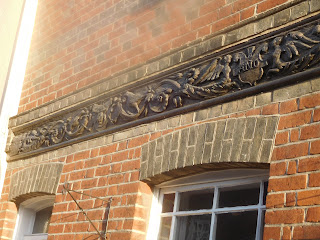Social Life in the 1890s
People in Coggeshall, especially young people, often comment that there is nothing to do here - no youth club, gym, bowling alley, cinema... So, how did people in the village entertain themselves in the past?
The "Essex Herald" dated 1893 gives us some idea. There is no doubt that the chapels and churches played a leading role in setting up groups of various kinds which offered periodical "Teas" and entertainments. Essentially these combined fun and philanthropy as they were either held to reward or to raise funds for a project of some kind.
A Parochial tea had been held to raise funds for the National Schools. Tables were provided by various benefactors, presumably supplying food and drink. Then there was a concert where villagers performed comic songs and recitations, often so well-received that encores were requested. The Beaumont children performed a crossing-sweeper's song "Please give a Penny" and were showered with pennies at the end, all of which added to the Almshouse fund. Some of the subject matter would be unthinkable now because of racial stereotyping, but an example still familiar to us is "The Man who Broke the Bank in Monte Carlo."
The "Guild of the Good Shepherd", presumably linked to the Roman Catholic church, held a tea where thirty sat down to tea followed by dancing and games, ending at 10pm.
The "Young Women's Help Society" held a Social Evening. This was a group which offered weekly classes in home dress-making, a savings bank and a benefit club. It had one hundred and eighty members. Prizes were awarded for regular attendance and good conduct. After refreshments there was an exhibition of "Mrs Jarley's Waxworks" which seems to have been an opportunity for fancy dress. Girls dressed up as "Punch and Judy", "Little Jack Horner" and "A Chinese Mandarin," among others, were introduced by Mr Surridge. It all seems so innocent, with its emphasis on self-improvement.
Fancy dress also made its appearance, rather curiously, in the Ice Carnival held opportunistically when the Mile Pond at Holfield Grange froze over. E.W.King, the seedsman, managed the whole affair to raise money for Mrs Beaumont's fund for the erection of almshouses. Over five hundred people attended, walking in procession the mile to the pond which was well-lit with scores of Chinese lanterns. Prizes were given for the best costumes - "Britannia", "An Indian Chief", Highland lads and lasses" - and tea and coffee were served on the ice. This all sounds like tremendous fun - but imagine the risks involved. As it happens, one child fell and sprained his wrist badly and that was it.
Mrs Sheldrake, of the Hamlet, had given blankets and in many cases money, to the deserving poor. Oddly, still, in 2024, a group of older ladies meet regularly at the church to knit and chat. What do they knit? Blankets and baby clothes which are donated in large quantities to those in need.


I found it fascinating how, in the earlier pieces, you traced the evolution of the various industries in the village and then related it to much wider contemporary political and economic developments. You’re now building an increasingly vivid picture of Victorian life in the village which is equally engaging. Really interesting stuff!
ReplyDeleteAlas, I missed this when it first came out. Do the almshouses still stand?
ReplyDelete